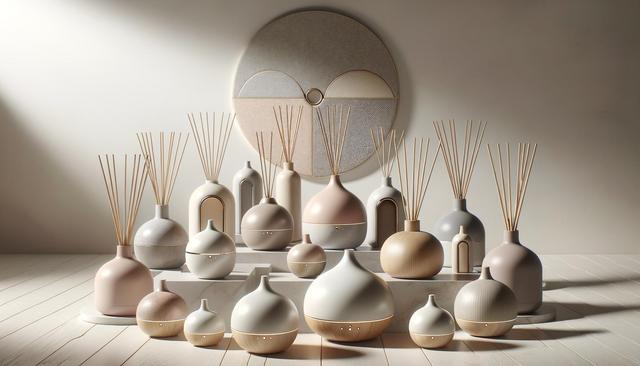Understanding How Fragrance Diffusers Work
Fragrance diffusers are designed to disperse essential oils or aromatic blends into the air, enhancing the ambiance of a space. They work by either using heat, ultrasonic waves, or simply by allowing the fragrance to evaporate naturally. Understanding how each type functions can help you decide which is most suited to your lifestyle and preferences.
There are several common types of diffusers:
- Ultrasonic diffusers: Use water and ultrasonic vibrations to disperse a fine mist of water and essential oil.
- Nebulizing diffusers: Do not use water or heat, instead they release pure essential oils into the air using pressurized air.
- Evaporative diffusers: Use a fan to help the oil evaporate and spread through the room.
- Heat diffusers: Use warmth to gently disperse fragrance into the air, though they may alter the chemical structure of essential oils.
Each diffuser type has its own pros and cons. For instance, ultrasonic diffusers double as humidifiers, while nebulizing models are known for delivering a stronger scent without altering the oil composition.
Key Features to Look For
When choosing a fragrance diffuser, there are several important features to consider that impact both performance and convenience. These features can help you narrow down your options based on your needs and the environment where the diffuser will be used.
Some useful features to evaluate include:
- Run time: Some models offer continuous operation for several hours, while others have interval settings to conserve oils.
- Tank capacity: Larger tanks mean fewer refills, which is ideal for larger rooms or extended use.
- Noise level: Ultrasonic diffusers are generally quiet, but it’s worth checking reviews if silence is important to you.
- Lighting options: Many diffusers come with integrated LED lights that can function as nightlights or mood lighting.
- Auto shut-off: A safety feature that turns the diffuser off when water runs low.
These practical aspects help ensure your experience is both enjoyable and low-maintenance, allowing you to enjoy aromatherapy with minimal effort.
Matching the Diffuser to Your Space
The size and layout of the space where you’ll use your fragrance diffuser should influence your choice. A small bedroom requires a different diffuser than a large open-plan living area or office. Choosing the right capacity and diffusion method will improve performance and ensure your space smells fresh and inviting.
Here are some space-specific recommendations:
- Small rooms (100–200 sq ft): Compact ultrasonic or heat diffusers often suffice.
- Medium rooms (200–400 sq ft): Consider mid-size diffusers with larger tanks and stronger diffusion.
- Large rooms (over 400 sq ft): Nebulizing diffusers or multiple units may be more effective.
Placement is also important. Positioning your diffuser away from direct sunlight or air vents can improve its longevity and performance. Ideally, place it on a stable surface at chest height to allow even scent distribution throughout the room.
Materials and Aesthetic Appeal
Beyond technical specifications, the materials and design of a fragrance diffuser also play a role in your purchase decision. With so many styles available, from minimalist to rustic, you can find one that complements your decor while still offering functionality.
Common materials include:
- Plastic: Lightweight and affordable, though not as durable or elegant.
- Ceramic or porcelain: Offers a more refined look, often used in heat diffusers.
- Glass: A popular choice for nebulizing diffusers due to its resistance to essential oils.
- Wood or bamboo: Brings a natural aesthetic, often used as an outer casing for ultrasonic units.
When selecting a diffuser, think about where it will be displayed. A well-designed model can act as a decorative piece in your home or workspace, blending function with style. Also, consider how easy it is to clean, especially if you plan to use various oils over time.
Maintenance and Oil Compatibility
Proper maintenance is key to ensuring your fragrance diffuser continues to perform well over time. Residue buildup, especially from thicker oils, can affect the diffusion process and shorten the device’s lifespan. Most manufacturers provide cleaning instructions, and following them regularly will help preserve the unit’s efficiency.
Here are some general maintenance tips:
- Clean the diffuser every few uses by wiping it down with a soft cloth and mild detergent.
- Avoid using oils with synthetic additives that can clog or damage components.
- Use distilled water if recommended, especially in ultrasonic models, to minimize mineral buildup.
- Empty and dry the tank after each use to prevent mold or mildew.
It’s also important to verify that the diffuser is compatible with the types of oils you prefer. Some models are better suited to thick or resinous oils, while others may only work effectively with lighter, more volatile options. Always refer to the manufacturer’s guidelines to ensure safe and optimal use.
Final Thoughts: Choosing a Diffuser That Fits Your Lifestyle
Finding the right fragrance diffuser involves more than picking a stylish device. It requires considering how and where you’ll use it, what features matter most to you, and how much effort you’re willing to invest in maintenance. Whether you’re aiming to create a serene bedroom retreat or a welcoming living space, taking the time to evaluate your needs can lead to a more satisfying purchase. With so many quality options available today, you’re likely to find a model that brings both function and aesthetic value to your environment.


